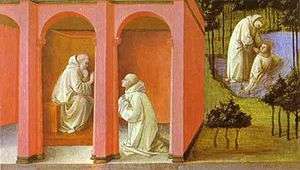Saint Placidus
- For the martyr of this name, see Saint Placidus (martyr).
| Saint Placidus | |
|---|---|
|
| |
| Died | 6th century |
| Venerated in | Catholic Church, Eastern Orthodox Church |
| Feast | 5 October |
| Attributes | being rescued from drowning |
| Patronage | Messina (co-patron), Biancavilla, Castel di Lucio, Montecarotto, Poggio Imperiale |
Saint Placidus (also known as Saint Placid) was a disciple of Saint Benedict. He was the son of the patrician Tertullus, was brought as a child to St. Benedict at Sublaqueum (Subiaco) and dedicated to God as provided for in chapter 69 of the Rule of St. Benedict (oblate).
Here too occurred the incident related by St. Gregory the Great (Dialogues, II, vii) of his rescue from drowning when his fellow monk, Saint Maurus, at Saint Benedict's order ran across the surface of the lake below the monastery and drew Placidus safely to shore. It appears certain that he accompanied Saint Benedict when, about 529, he removed to Monte Cassino, which was said to have been made over to him by the father of Placidus.
Of his later life nothing is known, but in an ancient psalterium at Vallombrosa his name is found in the Litany of the Saints placed among the confessors immediately after those of Saint Benedict and Saint Maurus; the same occurs in Codex CLV at Subiaco, attributed to the ninth century.
He is venerated together with Saint Maurus on 5 October.[1] He is the co-patron of Messina along with the Madonna of the Letter, and is the official patron of Biancavilla, Castel di Lucio, Montecarotto, and Poggio Imperiale.[2] Because a large portion of Easton, Pennsylvania's Italian community originally came from Castel di Lucio, Saint Placidus is given particular veneration with an annual parade through South Side on the Sunday before Labor Day. The Sunday after is the Feast of the Holy Cross, celebrated by immigrants from the neighboring town of Santo Stefano di Camastra.
Confusion with another Placidus
There seems now to be no doubt that the Passio S. Placidi, purporting to be written by one Gordianus, a servant of the saint, on the strength of which he is usually described as abbot and martyr, is really the work of Peter the Deacon, a monk of Monte Cassino in the twelfth century (see Hippolyte Delehaye).
The writer seems to have begun by confusing Saint Placidus with the earlier Placitus or Placidus, who, with Euticius and thirty companions, was martyred in Sicily under Diocletian, their feast occurring in the earlier martyrologies on 5 October. Having thus made Saint Placidus a martyr, he proceeds to account for this by attributing his martyrdom to Saracen invaders from Spain - an utter anachronism in the sixth century but quite a possible blunder if the Acta were composed after the Moslem invasions of Sicily. The whole question is discussed by the Bollandists.
The study that accompanied the 1969 revision of the General Roman Calendar[3] states: "Saint Placidus, the disciple of Saint Benedict, is now universally distinguished from Saint Placidus, the unknown martyr in Sicily".
References
- ↑ Martyrologium Romanum (Libreria Editrice Vaticana 2001 ISBN 88-209-7210-7)
- ↑ it:San Placido
- ↑ Calendarium Romanum (Libreria Editrice Vaticana 1969), p. 113
Sources
- Gardner, Edmund G. (editor) (1911). The Dialogues of Saint Gregory the Great (2010 ed.). Merchantville, NJ: Evolution Publishing. ISBN 978-1-889758-94-7.
External links
| Wikimedia Commons has media related to Saint Placidus. |
- Placidus at the Catholic Encyclopedia
- St. Benedict's Abbey - Benedictine Brothers and Fathers in America's Heartland
- The Holy Rule of St. Benedict - Online translation by the Rev. Boniface Verheyen, O.S.B., of St. Benedict's Abbey
- Benedictine College - Dynamically Catholic, Benedictine, Liberal Arts, and Residential
![]() This article incorporates text from a publication now in the public domain: Herbermann, Charles, ed. (1913). Catholic Encyclopedia. New York: Robert Appleton.
This article incorporates text from a publication now in the public domain: Herbermann, Charles, ed. (1913). Catholic Encyclopedia. New York: Robert Appleton.
